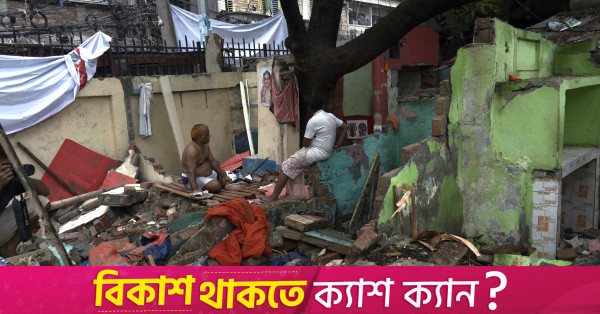The Harijan story: Children of god, forsaken forever?


The recent eviction drive by the Dhaka South City Corporation has made headlines and brought the miseries of the community to the fore once again. But this is not the first time Harijans have been removed from their house.
Murad Chowdhury sitting on salvaged pieces of cardboard among the rubble of cement and brick – the only remnants of a place he once called home. Photo: Ashraful Rafid/TBS
“>
Murad Chowdhury sitting on salvaged pieces of cardboard among the rubble of cement and brick – the only remnants of a place he once called home. Photo: Ashraful Rafid/TBS
14 June. Friday.
By 10:00am, most of the working men and women should have left the Miranzilla Harijan City Colony in the capital’s Bangshal to tend to their jobs.
But with lawyers, protestors and media workers crowding the place, it was hard to tell.
Most of the outsiders had congregated on the north side. But why had this crowd descended on a Harijan colony?
Four days ago, the Dhaka South City Corporation had razed dozens of houses and the colony’s sole kitchen market, leaving many residents homeless and without refuge.
It was an eviction drive with an eye towards constructing a modern market.
For many, the development spells disaster.
An area of the Mironzilla colony, which housed a kitchen market, was demolished by the Dhaka South City Corporation. Photo: Ashraful Rafid/TBS
“>
An area of the Mironzilla colony, which housed a kitchen market, was demolished by the Dhaka South City Corporation. Photo: Ashraful Rafid/TBS
‘When the bulldozers came, our house was first to fall’
At the far end of the narrow alley, flanked by cramped houses, connecting the north side to the colony’s main gate, stands a massive neem tree.
Beneath its branches, Murad Chowdhury and his cousin, Murad Roy, sit on salvaged pieces of cardboard among rubble of cement and brick – the only remnants of a place they once called home.
“This used to be a two-room house. We lived here with our fathers,” Murad Chowdhury, around 40, says.
“When the bulldozers came, our house was one of the first to fall.”
A narrow alley connecting the north part of the colony to the main entrance. Photo: Ashraful Rafid/TBS
“>
A narrow alley connecting the north part of the colony to the main entrance. Photo: Ashraful Rafid/TBS
The Murads and their fathers now sleep beneath the tree under open sky.
“Where will we go? We don’t own any land, nor can we afford to rent a house.”
Most Harijans, like Murad and his family, in the city either work for the city corporation or did at some point in their lives.
Yet, from time to time, it was the hand that fed them that targeted them the most.
The main entrance to Mironzilla Harijan City Colony. Photo: TBS
“>
The main entrance to Mironzilla Harijan City Colony. Photo: TBS
Inside view of city within a city
Spanning across some 327 decimals of land in Bangshal of Old Dhaka, the Miranzilla Colony is estimated to be 400-years-old.
While there is no specific data on how many people reside in the colony, local estimation varies in between 3,000-4,000 members of around 700 families.
The cacophony of sounds makes each alley snaking through the area come alive.
A strong smell of incense, mingling with the damp air, blankets the area.
The Shri Shri Ramanand Social Temple. Photo: Ashraful Rafid/TBS
“>
The Shri Shri Ramanand Social Temple. Photo: Ashraful Rafid/TBS
And it’s history, or the oral traditional version of it, drips with imagination.
“It was owned by Miran Baiji, a local singer-performer. During the British era, Miran donated the colony to Harijans, who were brought from India to work in tea estates, for cleaning services, rail services, etc,” said Bishnu Roy, a resident of the colony in his 80s.
Media reports state that members of around 500 families from the colony are currently involved in works under the city corporation. Members from the remaining 200 families also worked for the government body at some point of their lives.
For any first-time visitor, the colony takes the form of a mini city.
It has its own school, two temples, a water booth, a health centre, a community centre, a hotel, a building housing two Harijan organisations – Miranzilla Earth Club and Harijan Sebak Samity – and a common bathhouse.
The entrance is flanked by two six-storey buildings on each side, both undergoing some overhead expansion to deal with overcrowding.
The Bangladesh Hindu Buddhist Christian Unity Council arranged a protest against Dhaka Souths eviction of Harijans on 14 June. Photo: Ashraful Rafid/TBS
“>
The Bangladesh Hindu Buddhist Christian Unity Council arranged a protest against Dhaka Souths eviction of Harijans on 14 June. Photo: Ashraful Rafid/TBS
The majority of the area is dotted with shanty-like semi-pucca homes.
This is the home. This is the address.
“There is nowhere else for us to go. This is our permanent address. We don’t own any land. I grew up here. Raised my children here. Even married off one of my daughters here,” said Rima Rani, whose house was partially destroyed by the city corporation.
Rani now dabbles in the in-between – the space between the homed and homeless, in its literal form.
Children of god
While the colony appears self-sustaining, a long-running social stigma has haunted the Harijans for decades, mostly owing to their historic profession – that of sweepers and cleaners.
“I have heard from my grandfather that our ancestors used to work for British officials. After the British left, they served Pakistani officials. They cleaned the officials’ cars, their houses, their roads, their toilets. The pay was poor. They were served one meal a day,” said Shamim.
Shamim came to notice after his attempt at suicide following bulldozers razing his house.
A protest banner hangs on the walls of the community centre of Mironzilla City Colony. Photo: TBS
“>
A protest banner hangs on the walls of the community centre of Mironzilla City Colony. Photo: TBS
The gap between the ancestors and the current generation means now many Harijans have built a career outside of their ancestors’ profession.
Some are now able to send their children to schools outside of the colony.
But the majority of the population is still stuck doing the same old job their grandfathers and great-grandfathers did.
The social stigma surrounding the Harijans has also remained the same as before.
“No one will rent us homes, because of our profession. There have been many times when hotels refused to let us sit, shopkeepers refused to sell us goods,” Shamim lamented. “Is this how a citizen of this country is treated?”
Caste-away
The caste system, often written off as a relic, is also very real here in Miranzilla Harijan City Colony.
Most of the Harijans living in Bangladesh are Hindus.
The Harijans – literally meaning children of god – were christened the new name to shrug off the association with the term used to describe them – Dalit or untouchables.
The term Harijan or ‘Children of God’ was coined by Narsinh Mehta, a Gujarati poet-saint of the Bhakti tradition, to refer to all devotees of Krishna irrespective of caste, class, or sex.
Later, in a bid to help the Dalit community, Mahatma Gandhi first used it in the context of identifying Dalits in 1933 in a bid to reduce discrimination against the community.
But the change in terms had little effect on their social development.
Stigma has meant many are reduced to small pockets in major cities, where they are clustered together in colonies.
With little economic development, most Harijans can’t afford to pay for their children’s higher education.
“My grandfather did not study. Neither did my father. I have nine brothers and sisters. Of them, I am the highest educated- an SSC pass. I couldn’t finish college as I had to help out the family. My younger brother now studies in a high school. My son, eight years old, studies in a nearby school,” Shamim said, describing the educational qualities of his family.
Of the handful of those who have switched to other professions, most work as day labourers and some as waiters at restaurants.
“I work at a food shop in New Market. The pay is low. But it’s still better than the cleaning jobs. I have more respect now,” said Joy, 28, whose house was also demolished in the recent drive by the city corporation.
“But with the house gone now, I’m not really sure how I will survive.”
The Harijans have long been demanding a quota in government jobs to break out of the chain of cleaning jobs.
So far, the government has not allocated them any.
The recent eviction drive by the Dhaka South City Corporation has made headlines and brought the miseries of the community to the fore once again.
But this is not the first time Harijans have been removed from their house.
On 22 January 2019, 108 families living in the Gopibagh Railway Colony were evicted to make space for a Padma Bridge rail link project.
The wait for rehabilitation
Soon after the eviction drive at Miranzilla colony came to the spotlight, a group of 60 eminent citizens expressed their outrage over the Dhaka South City Corporation’s attempt.
Terming the eviction drive as inhumane and a gross violation of human rights in a joint statement issued on 13 June, they called for the rehabilitation of the colony residents.
“They did not voluntarily come and settle in Dhaka city; rather they were brought in to serve the townspeople. Given this reality, it is illegal to evict anyone except those currently working for the city corporation,” reads the statement.
Zakir Hossain, chief executive of Nagorik Uddyog, a platform working for the rights of Dalit, excluded and indigenous communities, also thinks ensuring proper housing for the Harijans is the first step to ensure their development.
“They are one of the oldest communities to settle in this city… and should not be identified as slum dwellers. Slum dwellers are those who have lost their homes and are now occupying open city spaces. But the Harijans live in ‘city colonies’.
“They don’t own any lands. The colonies are their permanent address. If the authorities want to evict them, they must first ensure their rehabilitation. Otherwise, it’s just inhumane,” he told The Business Standard.
Zakir said his organisation had asked the government back in 2011 for a housing project for the Harijans.
“Steps were taken in this regard. The government had approved a project. It is ongoing. If they complete the project, a lot of the problems will be solved.”
Some of the Harijans living in the country have already been rehabilitated, including in Kurigram, Jhenaidah and Sherpur.
Zakir also emphasised creating more opportunities for the Harijans to get into mainstream jobs.
“Some universities have launched quota systems for the Harijans. This has allowed some members of the community to pursue higher education in public universities. Similar opportunities can be created for government jobs.”



